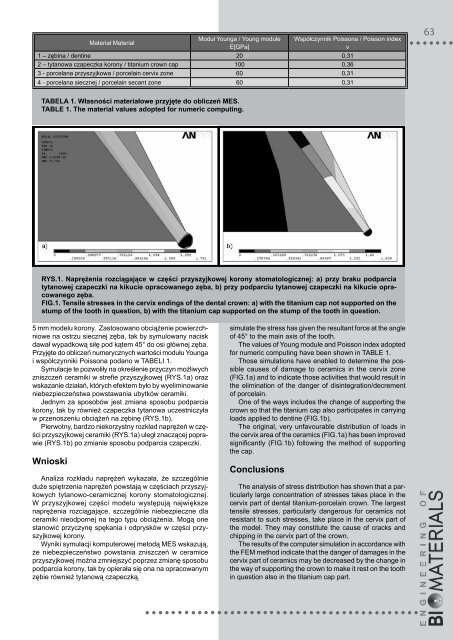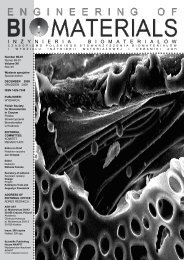69-72 - Polskie Stowarzyszenie BiomateriaÅów
69-72 - Polskie Stowarzyszenie BiomateriaÅów
69-72 - Polskie Stowarzyszenie BiomateriaÅów
Create successful ePaper yourself
Turn your PDF publications into a flip-book with our unique Google optimized e-Paper software.
Materiał Material<br />
Moduł Younga / Young module<br />
E[GPa]<br />
Współczynnik Poissona / Poisson index<br />
ν<br />
1 – zębina / dentine 20 0,31<br />
2 – tytanowa czapeczka korony / titanium crown cap 100 0,36<br />
3 - porcelana przyszyjkowa / porcelain cervix zone 60 0,31<br />
4 - porcelana siecznej / porcelain secant zone 60 0,31<br />
63<br />
TABELA 1. Własności materiałowe przyjęte do obliczeń MES.<br />
TABLE 1. The material values adopted for numeric computing.<br />
RYS.1. Naprężenia rozciągające w części przyszyjkowej korony stomatologicznej: a) przy braku podparcia<br />
tytanowej czapeczki na kikucie opracowanego zęba, b) przy podparciu tytanowej czapeczki na kikucie opracowanego<br />
zęba.<br />
FIG.1. Tensile stresses in the cervix endings of the dental crown: a) with the titanium cap not supported on the<br />
stump of the tooth in question, b) with the titanium cap supported on the stump of the tooth in question.<br />
5 mm modelu korony. Zastosowano obciążenie powierzchniowe<br />
na ostrzu siecznej zęba, tak by symulowany nacisk<br />
dawał wypadkową siłę pod kątem 45° do osi głównej zęba.<br />
Przyjęte do obliczeń numerycznych wartości modułu Younga<br />
i współczynniki Poissona podano w Tabeli 1.<br />
Symulacje te pozwoliły na określenie przyczyn możliwych<br />
zniszczeń ceramiki w strefie przyszyjkowej (RYS.1a) oraz<br />
wskazanie działań, których efektem było by wyeliminowanie<br />
niebezpieczeństwa powstawania ubytków ceramiki.<br />
Jednym za sposobów jest zmiana sposobu podparcia<br />
korony, tak by również czapeczka tytanowa uczestniczyła<br />
w przenoszeniu obciążeń na zębinę (Rys.1b).<br />
Pierwotny, bardzo niekorzystny rozkład naprężeń w części<br />
przyszyjkowej ceramiki (RYS.1a) uległ znaczącej poprawie<br />
(Rys.1b) po zmianie sposobu podparcia czapeczki.<br />
Wnioski<br />
Analiza rozkładu naprężeń wykazała, że szczególnie<br />
duże spiętrzenia naprężeń powstają w częściach przyszyjkowych<br />
tytanowo-ceramicznej korony stomatologicznej.<br />
W przyszyjkowej części modelu występują największe<br />
naprężenia rozciągające, szczególnie niebezpieczne dla<br />
ceramiki nieodpornej na tego typu obciążenia. Mogą one<br />
stanowić przyczynę spękania i odprysków w części przyszyjkowej<br />
korony.<br />
Wyniki symulacji komputerowej metodą MES wskazują,<br />
że niebezpieczeństwo powstania zniszczeń w ceramice<br />
przyszyjkowej można zmniejszyć poprzez zmianę sposobu<br />
podparcia korony, tak by opierała się ona na opracowanym<br />
zębie również tytanową czapeczką.<br />
simulate the stress has given the resultant force at the angle<br />
of 45° to the main axis of the tooth.<br />
The values of Young module and Poisson index adopted<br />
for numeric computing have been shown in table 1.<br />
Those simulations have enabled to determine the possible<br />
causes of damage to ceramics in the cervix zone<br />
(fig.1a) and to indicate those activities that would result in<br />
the elimination of the danger of disintegration/decrement<br />
of porcelain.<br />
One of the ways includes the change of supporting the<br />
crown so that the titanium cap also participates in carrying<br />
loads applied to dentine (fig.1b).<br />
The original, very unfavourable distribution of loads in<br />
the cervix area of the ceramics (FIG.1a) has been improved<br />
significantly (fig.1b) following the method of supporting<br />
the cap.<br />
Conclusions<br />
The analysis of stress distribution has shown that a particularly<br />
large concentration of stresses takes place in the<br />
cervix part of dental titanium-porcelain crown. The largest<br />
tensile stresses, particularly dangerous for ceramics not<br />
resistant to such stresses, take place in the cervix part of<br />
the model. They may constitute the cause of cracks and<br />
chipping in the cervix part of the crown.<br />
The results of the computer simulation in accordance with<br />
the FEM method indicate that the danger of damages in the<br />
cervix part of ceramics may be decreased by the change in<br />
the way of supporting the crown to make it rest on the tooth<br />
in question also in the titanium cap part.













